| Author | Message | ||
| Bob McSeveney (Scout70)
Registered Member Username: Scout70 Post Number: 8 Registered: 8-2008 Posted From: 146.129.252.126 Rating: N/A |
I have a 1973 MCI 5B and the parking brake is locked and will not release.It has been sitting for a couple of months and I suspect the brakes might be rusted? (The bus is undercover though). I have had no brake problems and have reviewed prior threads on what to do. The bus has an airdryer on it and the dryer kicks in at about 113PSI. I have been stabbing the brake at max PSI but so far the brakes won't budge. I am in the renton Washington area and I am going to try some more options, but, if nothing else works, can anyone refer me to someone local who knows this stuff and can come out and effect a repair? Any referral would be appreciated. Thanks in advance. bob | ||
| ED Hackenbruch (Shadowman)
Registered Member Username: Shadowman Post Number: 350 Registered: 11-2003 Posted From: 75.211.215.188 Rating: N/A |
Instead of "stabbing" the brakes, hold it down for 5-10 seconds and then release it and see if they have freed up. | ||
| Bob McSeveney (Scout70)
Registered Member Username: Scout70 Post Number: 9 Registered: 8-2008 Posted From: 146.129.252.126 Rating: N/A |
OK. I will try it this week. In the future I am going to block the wheels and avoid this hassle. It has never been a problem before, but, it has been sitting for a while and I understand things can change. | ||
| marvin pack (Gomer)
Registered Member Username: Gomer Post Number: 1216 Registered: 3-2007 Posted From: 71.55.4.4 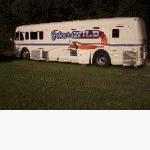 Rating: N/A |
BOB if youhave a parking brake system which I believe it is when the air pressure goes down it will automatically lock the brakes so blocking it will not do any good.I think that your bus has DD3's on it and they are serviceable. By that I mean you have a grease fitting on them and probably they are dry and a shot of grease will help them tremendously. It is not uncommon to have this problem either and as mentioned hold them down for several seconds as hard as you can and when you release them you will feel the coach move. Good Luck Gomer | ||
| George M. Todd (George_todd)
Registered Member Username: George_todd Post Number: 1174 Registered: 8-2006 Posted From: 99.146.10.157 Rating: N/A |
Lets discuss how DD3s work, and maybe it will help with a release. DD3s have two diaphragms, service and park/emergency, and a locking mechanism which mechanically holds the brake shoes applied after the air pressure leaks off. The lock rollers are held in the RELEASED position with air pressure, which is the 3rd air line to the brake cans. This is all controlled by the inversion valve which either applies air to the lock rollers and releases air to the park cylinder, or vice versa. Some buses were ordered with an optional feature which required a 100 psi foot pedal application after depressing the park knob to release the parking brake. As Gomer says above, "the parking brakes will apply automatically when the air pressure goes down to about 60 psi." Now, as the lock rollers hold ALL of the brake application force, and need a little help in releasing the tension, I suggest the following: 1. Don't be parked and holding a heavy foot pedal application when you pop the knob. This results in full foot pedal force being applied to the Scams by the service diaphragm, as well as full regulated force applied by the parking diaphragm. 2. To get a release when this happens, start the bus and build air. Watch the brake reservoir gauge, and just as the compressor cuts out on high pressure, fully apply and hold the brake pedal depressed, wait about 5 seconds, then push the knob. Release the pedal, and see if you are loose. If not, you have probably lost the inversion valve, which is located on top of the differential. HTH, G | ||
| Buswarrior (Buswarrior)
Registered Member Username: Buswarrior Post Number: 1979 Registered: 12-2000 Posted From: 174.91.142.215 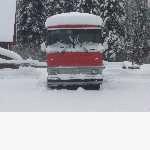 Rating: N/A |
Hello Bob. Never mind all the doom and gloom. Assuming that your parking brake has been performing flawlessly up until now... Why don't we try to break it free before we start disassembling our toys? If your linings are rusted to the drums, the challenge is applying whatever limited amount of force is available to you to break them free. As you have been doing, air it up, push in the parking control and apply a long and full brake application, and then try moving the coach, using as much power as you dare. Easier with an automatic, somewhat abusive to the clutch with a manual. Reverse is the more advantageous direction to get it to break free for the power available, from a brake geometry standpoint. As you are leaning against the rust using the engine, nail the brake pedal hard again, and then try moving in the other direction, lean against it, and nail the brake pedal. The idea is to introduce some shear to the bond of the lining to the drum, and give it a squeeze. Of course, at all times, being ready to catch it if it moves off! And, George, you can't compound a DD3, in your point #1, the plumbing won't let you. And, where is the schematic for this optional feature and the 100 lbs? Start a new thread if this one is going to drift. happy coaching! buswarrior | ||
| RJ Long (Rjlong)
Registered Member Username: Rjlong Post Number: 1779 Registered: 12-2000 Posted From: 71.195.124.20 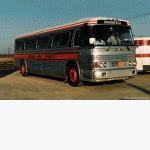 Rating: N/A |
George - "2. To get a release when this happens, start the bus and build air. Watch the brake reservoir gauge, and just as the compressor cuts out on high pressure, fully apply and hold the brake pedal depressed, wait about 5 seconds, then push the knob. Release the pedal, and see if you are loose." I believe you have this backwards. From all the literature I've read, plus conversations with Bendix technical service personnel, you DON'T apply full service brake pressure to a DD3 system BEFORE pushing in (releasing) the parking brake knob. The correct procedure, according to Bendix, is to release the parking brake first, then give a full service brake application, holding for approximately five seconds before releasing the pedal. FWIW & HTH. . .  | ||
| Nellie Wilson (Vivianellie)
Registered Member Username: Vivianellie Post Number: 511 Registered: 11-2008 Posted From: 66.87.2.140  Rating: N/A |
RJ - My instructions read the same. BUT sometimes when 'stuck' I've applied brakes first and then pushed knob. Don't ask me why, but it seems to work. Maybe it's like that caution "Do not start with clutch depressed." Well sometimes you have to... like when it absolutely will NOT go into first. And if anyone knows, what could it possibly hurt? Curious Nellie | ||
| Buswarrior (Buswarrior)
Registered Member Username: Buswarrior Post Number: 1982 Registered: 12-2000 Posted From: 174.91.142.215  Rating: N/A |
EH? If that is what #2 reads.. then that's the complete opposite and wrong according to the directive in #1 to NOT make a full service brake application while the parking knob is in the park position. The same conditions warned against would be created. If I'm confused, if RJ is confused, and if NELLIE is curious.... oh dear. happy coaching! buswarrior | ||
| Nellie Wilson (Vivianellie)
Registered Member Username: Vivianellie Post Number: 513 Registered: 11-2008 Posted From: 66.87.2.140  Rating: N/A |
Who's on first...? Nellie | ||
| Buswarrior (Buswarrior)
Registered Member Username: Buswarrior Post Number: 1984 Registered: 12-2000 Posted From: 174.91.142.215  Rating: N/A |
doomed, we are doomed. She knows the joke. happy coaching! buswarrior | ||
| Gus Causbie (Gusc)
Registered Member Username: Gusc Post Number: 1253 Registered: 11-2005 Posted From: 173.202.44.201 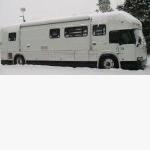 Rating: N/A |
I agree with RJ, I always push the knob in before I apply any foot pedal pressure, always works. Sometimes it even releases without foot pressure. | ||
| George M. Todd (George_todd)
Registered Member Username: George_todd Post Number: 1176 Registered: 8-2006 Posted From: 99.146.10.157 Rating: N/A |
BW, We have both posted here for years, and I think respect each other's opinions, so let me ask a question. If you are stopped in a position which requires you to hold a foot pedal application to hold your 9 (or my 6) still while applying the parking brake, do you hear a service brake release when applying the parking brake? The answer is no. (At least not on mine!) The total force applied is going to be the regulated parking pressure on the emergency/park diaphragm, plus the service brake pedal pressure. Secondly, it has been posted here about a year ago, by a buffalo owner I believe, in reply to his inability to release his brakes, and a request for help here, "Thanks for the help, I got the brakes released by holding down the pedal, Then I read the tag that says apply 100 pound foot pedal to release brakes." This is an OPTION, and I don't know how many buses out there have it, but there are several. RJ, I deliberately suggested the order I did, in an effort to apply maximum application force to the rod, in case the lock rollers are stuck on the shaft in the applied position. My suggestion applies all of the available air pressure to the brake system, and once the flow to the chambers has stopped, then a release is attempted. I hereby admit to driving mine for at least a couple of years applying the brake pedal every time I released the brakes, before I pushed the knob in a hurry, and the bus rolled free. Since then, I found that the parking brakes release without any pedal application every time. This is also true on 3 other MC6s that I have driven. Mine has sat for at least a year a couple of times, and has always released without problems, so I feel that Bob's problem is not his linings rusted to his drums. Much more likely the inversion valve diaphragm, the pilot valve, OR the emergency reservior pressure regulating valve not allowing enough pressure to the lock release? | ||
| Luvrbus (Luvrbus)
Registered Member Username: Luvrbus Post Number: 1032 Registered: 8-2006 Posted From: 74.33.43.204 Rating: N/A |
Oh the joy of spring brakes lol seriously Eagles with spring brakes you need to push the button then the pedal to release the spring brakes a Eagle thing | ||
| Buswarrior (Buswarrior)
Registered Member Username: Buswarrior Post Number: 1990 Registered: 12-2000 Posted From: 174.89.178.15  Rating: N/A |
Sorry Bob, a little highjack of your thread, how are you making out? George, perhaps we need to agree that for many years, when it comes to dd3's, you post stuff that is incorrect, and I get to do the work? Until we see some evidence, I suggest there is no optional feature for the DD3 parking release. Stop perpetuating this myth and misleading other busnuts. Brakes are complicated enough as it is. I have found nothing credible in reference to this. Tags on the parking control valve come and go over the years, and mean nothing. I do, however, look forward to being proven wrong. Whether DD3 need a brake application or not has to do with the pressure at the chamber at time of parking versus time of release, and the condition, or lack there of, of the locking rollers, the push rod shaft on which they contact, the pressures in the parking tank, the pressure regulator, the inversion valve, the foot valve, the parking control valve, the relay valve, the check valves, all the interrelated piping, and the phase of the moon, all of which is a crap shoot on many bus conversions. How many calibrated springs are we assuming are working correctly in there? Part of the problem in understanding this interrelation, we cannot see the pressure in the parking tank or at the brake chamber ports without adding our own gauges. And, you cannot compound a DD3. Check your plumbing diagrams and the functionality of the valves involved at Bendix. It was designed to prevent this, and the busnuts on here deserve better than made up posts. By compounding, I mean adding the force of both the service brake application and the parking application together at the output of the DD3 brake chamber. Can't be done in a properly working system. How are you going to get the inversion valve to direct parking tank air pressure to the parking portion of the chamber, if the inversion valve is being pressurized into a parking brake released configuration via the exhaust circuit of the parking control valve, by the heavy service brake application? An inversion valve's "diaphragm" is an exhaust cover and is not a functional item. There is no "pilot valve" in the circuit. There is no "emergency reservoir", do you mean the parking reservoir? The same regulator that might be failing delivers the same faulty pressure to both ends of the DD3, so the parking application will be just as weak, and in that case, the coach will drive against a weakly set parking brake. Patience for brake foolishness? I have none. happy coaching! buswarrior | ||
| Edward J. Sommers (Sommersed)
Registered Member Username: Sommersed Post Number: 64 Registered: 10-2004 Posted From: 148.63.161.138 Rating: N/A |
What happened to banging on the drum with a big hammer letting the resonating vibrations release the shoes? Ed | ||
| Buswarrior (Buswarrior)
Registered Member Username: Buswarrior Post Number: 1991 Registered: 12-2000 Posted From: 174.91.145.63  Rating: N/A |
That comes next, Ed. Lazy man tries to keep his tools in the box for as long as possible. No matter the reason, crawling under there safely is going to be a big task, so avoiding it saves a lot of work! happy coaching! buswarrior | ||
| George M. Todd (George_todd)
Registered Member Username: George_todd Post Number: 1178 Registered: 8-2006 Posted From: 99.146.10.157 Rating: N/A |
BW, 1. You didn't answer my question about "hearing a service brake release when applying the parking brake," which was my way of asking you how the anti-compounding feature could work as you describe. 2. By straight dictionary definition, the park/emergency knob "pilots" the operation of the inversion valve. 3. Doing all the work? Lastly I must remind you of your post of approximately 3 years ago, wherein you said: "...don't perpetuate the use of slang by calling it an inversion valve..." to which I replied that it is called an inversion valve in my MCI maitenance manual. Your reply was "I am dumbfounded and will retire." 4. IF you can't compound a DD3, why does applying the parking brake with the service brake pedal depressed cause so many cases of sticking brakes? (I know the answer, heretics and defective equipment.) 5. Do all of us a favor, and don't try and split hairs by saying there is no emergency reservoir, in the future, I will be VERY careful to call it "the park/emergency reservoir EVERY time. G | ||
| marvin pack (Gomer)
Registered Member Username: Gomer Post Number: 1224 Registered: 3-2007 Posted From: 71.55.4.4  Rating: N/A |
IAN!!! Better yet CHESSIE Where are you ?? gomer | ||
| Buswarrior (Buswarrior)
Registered Member Username: Buswarrior Post Number: 1995 Registered: 12-2000 Posted From: 174.91.145.63  Rating: N/A |
Keep going George, quite selective. You've still more explaining to do from further up the thread. A simple "I didn't know what I was typing about" will do. happy coaching! buswarrior | ||
| Buswarrior (Buswarrior)
Registered Member Username: Buswarrior Post Number: 1996 Registered: 12-2000 Posted From: 174.91.145.63  Rating: N/A |
George, perhaps you should go back and read it more carefully? http://www.busnut.com/bbs/messages/233/22751.html You continue to be a menace to busnuts trying to learn how their brakes work. happy coaching! buswarrior | ||
| Dave Walker (Chrome_dome)
Registered Member Username: Chrome_dome Post Number: 206 Registered: 3-2010 Posted From: 67.174.144.159 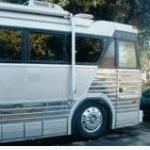 Rating: N/A |
Gomer; This is gonna get ugly. Should we duck? We shouldn't let them play together anymore. | ||
| marvin pack (Gomer)
Registered Member Username: Gomer Post Number: 1225 Registered: 3-2007 Posted From: 71.55.4.4  Rating: N/A |
Duck my foot! RUN!! IAN WHERE ARE YOU!! How about CHESSIE? LOL Gomer | ||
| john w. roan (Chessie4905)
Registered Member Username: Chessie4905 Post Number: 2026 Registered: 10-2003 Posted From: 71.58.71.157 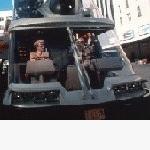 Rating: N/A |
My 4905 has emergency release levers on the end of the pushrods, where the slacks connect.They don't totally release the brakes, but allow movement off the road to a safe place. I don't know if they are available on other coaches. | ||
| Gus Causbie (Gusc)
Registered Member Username: Gusc Post Number: 1255 Registered: 11-2005 Posted From: 173.202.19.251  Rating: N/A |
I say put them into a ring with really thick gloves and let'm duke it out!!! If this doesn't happen it will go on forever. | ||
| George M. Todd (George_todd)
Registered Member Username: George_todd Post Number: 1179 Registered: 8-2006 Posted From: 99.146.10.157 Rating: N/A |
Jokes aside, everyone here can see all that has been posted, and please note who did the name calling, and who deliberately doesn't respond to specific questions. Also please note the archival post, and the failure to post the thread from the owner who posted the tag on his bus requiring a foot pedal application. I'm done, I've never called anyone names, and I won't start now. G | ||
| Buswarrior (Buswarrior)
Registered Member Username: Buswarrior Post Number: 1997 Registered: 12-2000 Posted From: 174.89.177.175  Rating: N/A |
It is very clear who is not able to explain himself, misquotes past threads, selectively argues diversionary points, and won't provide references. However, George, your flaming expertise is apparent. Your aptitude in DD3 is not. Stop misleading busnuts with your self important noise. happy coaching! buswarrior | ||
| les marston (Les_marston)
Registered Member Username: Les_marston Post Number: 267 Registered: 1-2010 Posted From: 68.151.225.213 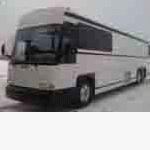 Rating: N/A |
You guys both know a lot more about brakes than most of us do so I would like to hear from both of you on a problem that I have re brakes on a 102 D 3 Lots of air venting through the bottom of the brake air valve. Replaced the valve and it still vents. Possible problems would be the solenoid valves that control front and rear brakes? There are two of them. How do I test them to see if that is the problem? Extra symptom. It takes a long time to air up the accessory tank causing long low air warning even when the two needles on the gauge are at 120 lbs | ||
| C. K.. Sparks (Kozycade)
Registered Member Username: Kozycade Post Number: 55 Registered: 7-2010 Posted From: 71.161.46.31 Rating: N/A |
Hello all! I will throw in my two cents here on the DD3 stuck parking brakes referencing an MCI MC7. After driving one for a business owner to haul him around the country I purchased my first MC7 and it was extremely difficult to get the brakes to release from the purchase forward. The proper procedure to get going after the bus airs up is to release the parking brake by pushing in the knob in without your foot applying the service brake pedal. After the parking brake is released, Momentarily apply the service brake pedal and hold for a couple of seconds. If all adjustments are within spec when you release the service brake you should roll without problem. Often, as was the problem with my sticking parking brakes, the pressure on the valve to release the parking brake should be set to 85 psi, no more, no less. This allows the stabbing of the service brake higher air pressure to fully release the parking brake. Mine was actually set at 110 psi if I recall correctly therefore being hit or miss of fully releasing the brakes. Once lowered and set to 85 psi there has never been an issue with sticking brakes. Sorry in advance if this was repetitive. Just my two cents worth of a wooden nickel. Kade (Message edited by KozyCade on February 12, 2011) | ||
| Edward J. Sommers (Sommersed)
Registered Member Username: Sommersed Post Number: 65 Registered: 10-2004 Posted From: 148.63.161.138 Rating: N/A |
All this crap and I still do not know if bill got his brakes to release. That's all he asked for as I recollect. Ed | ||
| Buswarrior (Buswarrior)
Registered Member Username: Buswarrior Post Number: 1998 Registered: 12-2000 Posted From: 174.89.177.175  Rating: N/A |
Les, by "brake air valve" do you mean the foot valve or?? This is on your 1994 D3? happy coaching! buswarrior | ||
| les marston (Les_marston)
Registered Member Username: Les_marston Post Number: 270 Registered: 1-2010 Posted From: 68.151.225.213  Rating: N/A |
Yes it is the foot valve but it is not a treadle valve. It mounts against the back of the spare tire compartment and is actuated by a rod that comes from the brake pedal. It has 10 air lines going to it and two air over electric switches. I am told that this valve controls both the front and rear brakes. Two of the air lines go to external switches that I believe control the stop lights and possibly the indicator light on the dash but I am not sure of that Les | ||
| Tim Brandt (Timb)
Registered Member Username: Timb Post Number: 587 Registered: 10-2003 Posted From: 99.122.63.218 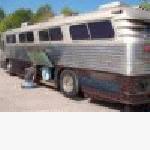 Rating: N/A |
Les the treddle valve on my Flx is mounted remotely like that as well | ||
| George M. Todd (George_todd)
Registered Member Username: George_todd Post Number: 1180 Registered: 8-2006 Posted From: 99.146.10.157 Rating: N/A |
Les, I don't have a schematic on your brake system, which has more parts in it than mine, but if I were to hazard a guess, I would say your brake valve problem is being caused by the rear brake relay valve. This valve's purpose is to speed up the application and release of the drive axle service brakes by not requiring all of the air going in and out of the chambers to travel through the front valve. This valve has the rear service brake reservoir pressure connected to it, and uses that to apply the drive axle brakes on a signal thru a smaller line from the foot valve. When the foot valve "signal" pressure decreases, the rear relay valve exhausts brake chamber air directly. If the rear relay valve fails and leaks air through it, that air will come out the foot valve exhaust port continuously as yours is doing. | ||
| Buswarrior (Buswarrior)
Registered Member Username: Buswarrior Post Number: 1999 Registered: 12-2000 Posted From: 174.89.177.175  Rating: N/A |
I'll support George's hunch. (the rest of you may pay off your bets, George and I are able to agree sometimes) Either that or the rebuild has a problem, but I'd go for the first, first. All the lines went back where they came from, I'm assuming? You have to find which of the output lines is feeding back when it shouldn't. 10 lines, really? The two electric switches I assume will be redundant brake light signals from both front and rear circuits. Find the pneumatic signal line for the rear and see if it is feeding back. There should only be pressurized air fed to the valve on two lines, one for front and one for the rear. The rest of the forest will have a reason, but to figure it out... Do you have the schematic for this coach? happy coaching! buswarrior | ||
| les marston (Les_marston)
Registered Member Username: Les_marston Post Number: 271 Registered: 1-2010 Posted From: 68.151.225.213  Rating: N/A |
I don't have a schematic for the air systems on this coach. Is it possible to have two brake relay valves? to the left of the main brake valve ( the one I replaced, new) are two more smaller valves. Each has a 3/8 air line going to it from the main valve, both also have electrical and smaller air lines going ????? The air lines that go to these two valves , assuming that they are signal valves, should not have air going to them unless the brakes are applied. Is this correct? and if so then by airing up the coach and disconnecting these lines one at a time I should be able to detect the fault in the signal valve? I will be getting a schematic for this coach. Thanks Les | ||
| Buswarrior (Buswarrior)
Registered Member Username: Buswarrior Post Number: 2001 Registered: 12-2000 Posted From: 174.89.177.175  Rating: N/A |
You are on the right track, Les. Anti-lock brakes? and some inter relation between the parking and the service brake systems will explain it all. They have chosen to put all the connections in one place I guess. I might be able to squeeze a trip to the coach company in today and see if they still have the right vintage maintenance manual. The last of the D models were traded in last year. What is your vin/unit number details? happy coaching! buswarrior | ||
| Buswarrior (Buswarrior)
Registered Member Username: Buswarrior Post Number: 2002 Registered: 12-2000 Posted From: 174.89.177.175  Rating: N/A |
BOB, how are you making out with the original thread topic of the coach stuck? happy coaching! buswarrior | ||
| Buswarrior (Buswarrior)
Registered Member Username: Buswarrior Post Number: 2005 Registered: 12-2000 Posted From: 174.89.177.175  Rating: N/A |
Bob reports offline that the coach came free by itself on a subsequent attempt with a bit more brake pedal use. Always nice when it doesn't involve tools! happy coaching! buswarrior | ||
| les marston (Les_marston)
Registered Member Username: Les_marston Post Number: 272 Registered: 1-2010 Posted From: 68.151.225.213  Rating: N/A |
vin# 1M88DMTA2RPO46766. not sure where I would get the unit number but I do know that it belonged to someone in Gillette WY Possibly a company called Cusa Elco? This may have been just a holding company. It would be interesting to learn the history of this coach Thanks again Les Bob: sorry to hijack this thread with my issue. I hope yours is resolved L | ||
| Roderick W. Chandler (Rod)
Registered Member Username: Rod Post Number: 73 Registered: 11-2003 Posted From: 173.185.3.211 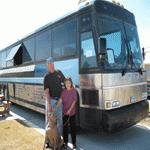 Rating: N/A |
Les I have the D3 air schematic. It prints out so small that it is unreadable. had to take it to someone with a plotter to print it out in a size I could read. Now I can't find my print out. Wife has been tidying up my desk again. Will send the file if you wish. Rod | ||
| Buswarrior (Buswarrior)
Registered Member Username: Buswarrior Post Number: 2006 Registered: 12-2000 Posted From: 174.91.143.212  Rating: N/A |
Ok, pages were missing from the last dust covered book we found buried... oh well.. Rod, I'd love a copy of that file, my address is in my profile. The mechanics report that there are pneumatic feeds for the transmission retarder run off there too, and the first comment included profanity about the mass of connections and no space to work in. Block the wheels and release the parking brake, does the leak go away? happy coaching! buswarrior | ||
| les marston (Les_marston)
Registered Member Username: Les_marston Post Number: 273 Registered: 1-2010 Posted From: 68.151.225.213  Rating: N/A |
Hi Rod Don't you just love it when the "just tidy up a bit"? Toni cleaned up my little shop once. Some stuff I still haven't found. It is all there somewhere. Yes please I would like a copy of that diagram if you can find it. I had intended to see if MCI could send me one but if yours is handy and you don't mind it will save me being a bug to them. They have been great! BW Yes the air leak stops when the park brake is off. but I still seem to be loosing air out of the accessories system very quickly. I think that one might be a leaking wiper motor but not sure yet. You said that the transmission retarded is run off it somewhere. Are you referring to a retarder brake? because I don't have a retarder, this coach has Jake brakes. I am curious because I am also having a problem with the transmission Allison B500. It wont go into gear. could the two issues be related as I first thought they might? I was talking about it on another thread that I started called "LOW VOLTAGE" | ||
| Buswarrior (Buswarrior)
Registered Member Username: Buswarrior Post Number: 2009 Registered: 12-2000 Posted From: 174.91.143.212  Rating: N/A |
Classic DD3 diaphragm leak symptoms. Squeeze off the service line to the DD3, one at a time, and see which side stops the leak. Then you can sit down somewhere safe, where you won't hit your head if you feel faint, and start pricing diaphragm replacements. Yes, if your B500 had a retarder, the retarder is pneumatically controlled. We need an air schematic for your coach! Do you still have the coach ID plate affixed to the entry stairway? The unit number will be imprinted on there. happy coaching! buswarrior | ||
| George M. Todd (George_todd)
Registered Member Username: George_todd Post Number: 1181 Registered: 8-2006 Posted From: 99.146.10.157 Rating: N/A |
Rod, Would you please send me the air schematic also? toddelec at psyber dot com , if you get what I mean, thanks! Les, You've thrown us a curve with the air leak going away when the parking brake is released. Rampant speculation, if yours is spring brakes, (and its about at the year MCI changed over,) is that the spring brake relay valve has failed, but that doesn't explain how the rogue air is coming out the foot valve exhaust, especially with the spring brakes applied, (no air.) Yours is spring brakes, right? If its DD3s, that makes it explainable, the inversion valve is leaking thru, or a diaphragm on one side has failed, and parking air is getting into the service chamber. More trivia for lack of a better word, aka a WAG. Lots of older buses use an electrically controlled-air operated transmission shifter... When they are wired correctly, the engine can't be shut off unless the trans is in neutral, and of course won't start unless the shifter is in neutral. Wat 'til you start one that was shut off in reverse, remember no air to shut it down, or shift it, an 8V92, so no emergency stop, and some poorly adjusted brakes. Due to the leaks we were looking for, it would only get about 30 psi, so I had to sit there with my foot on the brake pedal and hope it would sit still for the 20 minutes it took for the owner to get back from the hardware store and push the governor stop lever. Fortunately it only moved back about 6 of the 10 feet of space there was between the bus and a wall. Enough of that, when we get some info, we'll try to give you an intelligent answer! Good luck, G (Message edited by George todd on February 13, 2011) (Message edited by George todd on February 13, 2011) | ||
| les marston (Les_marston)
Registered Member Username: Les_marston Post Number: 274 Registered: 1-2010 Posted From: 68.151.225.213  Rating: N/A |
George. I don't think these are spring brakes in a 1994 D3. I don't think i will be pinching off any air lines that I want to continue to use as they are very hard plastic Thick wall high pressure air brake lines. I will look for the plate for the unit number, I think it is still there. I will also take some pictures of the, what I think they are, relay valves. I hope Rod is able to find his diagram of the air system but Rod if you cant please let me know and I will see if I can get it from MCI. Thanks Les | ||
| George M. Todd (George_todd)
Registered Member Username: George_todd Post Number: 1182 Registered: 8-2006 Posted From: 99.146.10.157 Rating: N/A |
Les, A quick way to check is to count the number of hoses going to the brake chambers. 2=Spring Brakes, 3=DD3s. Both of us can only justify 4 lines to the brake valve, 6 when you add the 2 to the switches you describe. The front brakes will PROBABLY have a quick-release valve connected between the foot valve and the front chambers, which looks like a relay valve, only no reservoir air connected to it. Mine has the front and tag axle air supplied from the front reservoir, and the drive axle supplied from the rear, FWIW. | ||
| ED Hackenbruch (Shadowman)
Registered Member Username: Shadowman Post Number: 355 Registered: 11-2003 Posted From: 75.211.177.199 Rating: N/A |
Going back to the original problem for a second, I found that if i apply the parking brake when i am at full air pressure that i may have a hard time releasing it the next time. What i try to remember to do each time i set the brake is to fan the pedal a few times to drop the air pressure 5-10 lbs before i set the brake. Makes it much easier to release them the next time. | ||
| Buswarrior (Buswarrior)
Registered Member Username: Buswarrior Post Number: 2010 Registered: 12-2000 Posted From: 174.89.174.235  Rating: N/A |
Ed, you need to check the pressure setting on the parking brake regulator. Should be at 85 lbs for an MC8. The higher the pressure allowed in the parking circuit, the more difficulty getting them to release. You can tap in anywhere that you can get an accessible fitting down the back, on the chamber, the inversion valve or the regulator itself, to easily take apart and put a gauge on it. It would be good preventive maintenance to change out the regulator, along with the inversion valve, if they are of unknown vintage. Les has DD3's. Les, if you prefer, take apart one of the service lines on a brake chamber. Whichever end of the fitting the air is running from points to the offending chamber. You have to separate them to determine the direction from which the air is coming, as it is a common circuit and the presence of air is insufficient for making assumptions. happy coaching! buswarrior | ||
| Brian Evans (Bevans6)
Registered Member Username: Bevans6 Post Number: 5 Registered: 5-2009 Posted From: 65.92.55.169 Rating: N/A |
Ed, the air pressure that sets the parking brake doesn't come directly from the dry tank, it comes from the parking/emergency tank. That is separated from the dry tank by, among other things, check valves set up so that the parking/emergency tank retains the highest pressure that it ever sees. So it will normally be sitting at 120 psi, or what your governor is set to for maximum pressure. When you fan your pressure down, that's affecting the pressure in the dry tank and the accessory tank, but doesn't affect the pressure in the parking/emergency tank. As noted by Buswarrior, air goes to the emergency port on the DD3 (via the inversion valve) through a pressure regulator that should be set to 85 PSI maximum, and is located (on my bus) on the front passenger side wall of the drive axle space. As long as the pressure in the parking/emergency tank is higher than 85 psi, and the release mechanism on the DD3's is in good nick, just pushing in the push pull valve should release the parking brake. You only need to do the full brake applications sometimes, to ensure the brakes release fully, but it's always a good idea to do that, just to be sure. Cheers, Brian | ||
| les marston (Les_marston)
Registered Member Username: Les_marston Post Number: 275 Registered: 1-2010 Posted From: 68.151.225.213  Rating: N/A |
I have sent the diagram for the air system for the MCI D series coach to George and Buswarrior. Does anyone else need it? | ||
| Buswarrior (Buswarrior)
Registered Member Username: Buswarrior Post Number: 2014 Registered: 12-2000 Posted From: 174.89.178.206  Rating: N/A |
Holy small print Batman! I gotta see what the equipment at work can do to make these very thorough diagrams bigger. happy coaching! buswarrior | ||
| Roderick W. Chandler (Rod)
Registered Member Username: Rod Post Number: 74 Registered: 11-2003 Posted From: 173.185.3.211  Rating: N/A |
All I have been able to find is the one that I printed and the one MCI faxed me. Both are too small to see even with magnifying glass. Guess I will have to take file back to my friend with the blueprint plotter. Rod. | ||
| Buswarrior (Buswarrior)
Registered Member Username: Buswarrior Post Number: 2017 Registered: 12-2000 Posted From: 174.91.143.92  Rating: N/A |
OK, I can see now! Where were we? happy coaching! buswarrior | ||
| les marston (Les_marston)
Registered Member Username: Les_marston Post Number: 277 Registered: 1-2010 Posted From: 68.151.225.213  Rating: N/A |
Looking at a serious drop in temperature here in Edmonton so I think I might be done playing bus for a bit. This issue to be continued after old man winter decides to bugger off Les | ||
| Bob McSeveney (Scout70)
Registered Member Username: Scout70 Post Number: 10 Registered: 8-2008 Posted From: 146.129.252.126 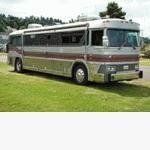 Rating: |
Just to let everyone know I did follow the summary advice listed early on the post and the brake released on the first attempt. Lesson learned!! Thank you all for your advice. |